They made Open Source Body
Published 30 January 2018 by la rédaction
Hailing from Israel, Spain, Netherlands, Russia, Italy and France, they participated in the Open Source Body festival to defend their vision of open hardware for open science. Portraits.
Paula Pin and HardGlam
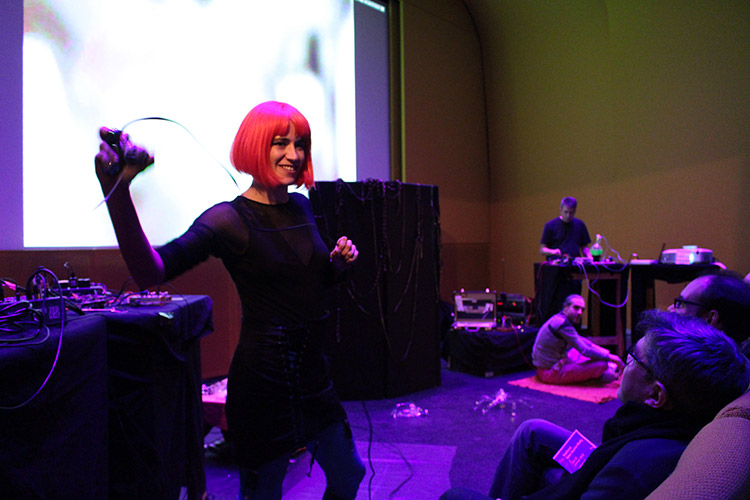
Barcelonian artist Paula Pin was one of the major guests of the Open Source Body festival, which took place in Paris on January 22-27 with a full program. With her team of MrSoza, Marc Dusseiller and Urs Gaudenz of Hackteria and GaudiLabs, she led the “Open Science Friction and Noise Disturbance” workshop all week at La Paillasse, presenting the tools of her Biotranslab at La Gaîté Lyrique’s Resource Center, before performing her [[Performative lab]o[dy Ritual]] with her partners for the closing ceremony.
While Paula Pin is perceived as a figure of the GynePunk movement, which she helped promote, she doesn’t like to see her activity reduced to this term, joking with her friend Urs Gaudenz about “gynepops and gaudipunks”. She has been collaborating much longer with the international Hackteria network, presenting her research for the past several years as “transhackfeminist” at the frontiers of “biology, art and queer science”.
Paula promotes a “HardGlam” esthetic, an “Open Science Friction” methodology and a “witch-cyborg” strategy. Plants, micro-organisms, alternative energies, the laboratory issue, have all forced her to rethink her body from a new angle, integrated into a complex network of interactions, confusing matters between machines, animals and plants. She develops tools beyond their simple utilitarian function to transform them into “magic tools for communicating with queer beings”. These tools are “glamorous, as they possess their own numen,” she says. She considers that “knowledge is acquired through the magical experience of the body, true feeling, which implies expressing and transforming oneself through transcendantal friction,” noting that, “as with sex, no amount of theorizing or intellectualizing can replace the true experience of doing”. The image of the witch means a lot to her, because “Witches have creativity, fantasy and innovation built into their body and use technology not only from a pragmatic point of view but also for spiritual tasks.”
Guy Aidelberg and bio for all
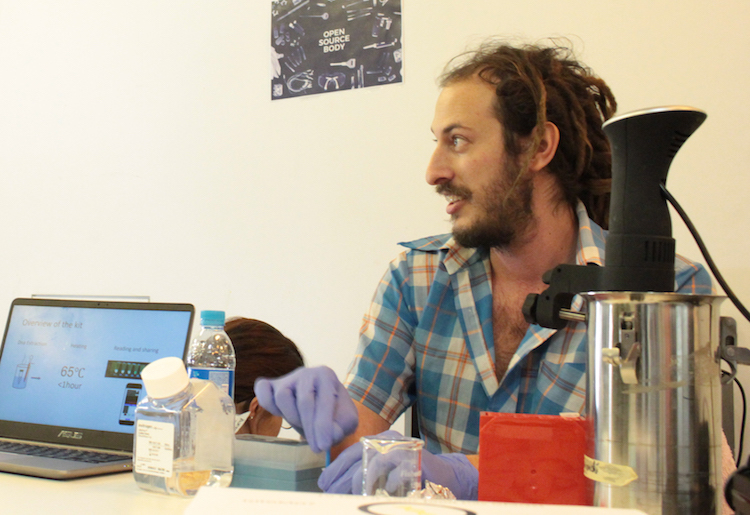
With his ultra low-tech, ultra low-cost GMO detector, Guy Aidelberg, PhD candidate at the Centre de recherches interdisciplinaires (CRI), invited people to test their food live to see whether or not it had been genetically modified. The test itself was ultra-simple: mix crushed foods with boiling water and heat to 63° for an hour using Loop-mediated isothermal amplification (LAMP), a process that amplifies DNA at a constant temperature. “The entire process takes no more than an hour-and-a-half. I often do the experiment with high school students, because in just a few minutes, you can already see a result and it’s very stimulating,” he adds.
This is hardly Guy Aidelberg’s first DIYbio kit. With Bio-TLV, the first biohackerspace in Tel Aviv, which he cofounded in 2016, he first thought of a kit for non-scientists to detect the Zika virus before coming to GMO. “I’m passionate about biology, but fundamentally, I come from human sciences. I didn’t want to do science for science without questioning it. Something was missing, a social, educational context. That’s why a friend and I decided to open a biohackerspace, so that people could do biology in a non-academic way, but also develop artistic and educational projects.” In order to promote his GMO detector, he intends to launch a crowdfunding campaign and is looking for other applications to detect allergens, pathogens or invasive species. “In fact, there’s no limit!”
Wieke Betten and ethics in genetics
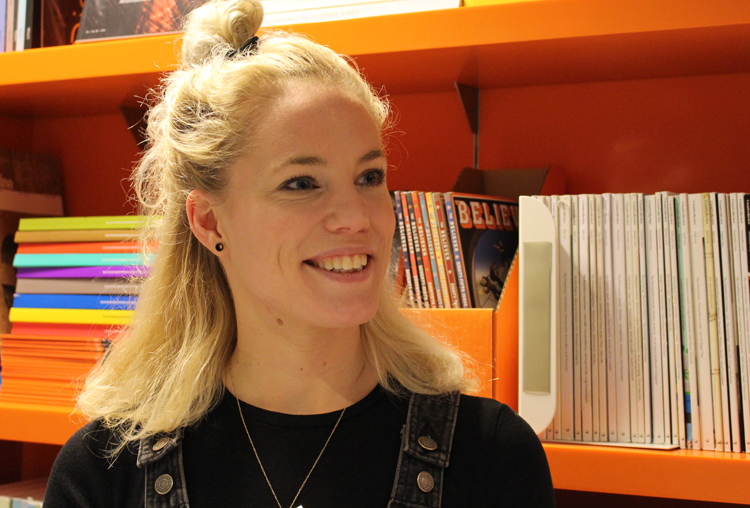
Introducing a bit of ethics into all this genetics, Wieke Betten presented her Gene.coop project, which she is developing with Waag Society in Amsterdam. The idea is to build a cooperative biology database so that anyone can retain control over the use of their genetic data, including in the case of commercialization by a third party, says the 33-year-old researcher, who also teaches at the VU University of Amsterdam. “The goal is to remove the ethical questions from their limited circles and help as many people as possible refine their arguments around these complex issues, so that they can decide freely what to do with their genetic data,” adds this postdoc researcher who lectures at Waag Society on the ethical pitfalls encountered by biotechnologies amidst the popularization of sciences and techniques.
Along with the other founders of Gene.coop, she decries the opacity of a system that took human genetic material out of the research labs to be sold and exploited in a multitude of products and services, all without the authorization of the donors. It has become a freeway for the pharmaceutical industry, which conveniently lurks behind the blurred destiny of personal genetic data. To counter this phenomenon, the cooperative is advancing a virtuous business model, where each individual remains the owner of his or her data, while being to free to monetize it or not. “Gene.coop is definitely a project based on citizen responsibility, but also on doing it together,” says Wieke.
André Maia Chagas and the open source microlab

A neuroscience researcher at the University of Tuebingen in Germany, André Maia Chagas cultivates his passion for DIY and open source in the field of Open Science Hardware. With two university colleagues, he founded Open Neuro Science, a central repository for open projects in neurosciences, as well as Prometheus Science, a start-up dedicated to producing and disseminating open source tools to labs worldwide. His first successful project was FlyPi, developed with the NGO Trend in Africa. Semi-finalist for the Hackaday prize in the citizen science category in 2016, FlyPi is an open source all-in-one mini biolab. High-resolution microscope, fluorescent imaging, optogenetics… The 3D-printed device can also perform parasitic diagnoses and blood analyses for about 100 euros, which is 10-50 times cheaper than tests made by the same kind of equipment sold on the market.
“With Trend in Africa, we organize Open Labware a bit everywhere in Africa to help African scientists develop their own solutions,” says André. “It’s a kind of Open Tour for research during which we explain the philosophy of open source and the practices that came out of the maker movement by teaching African researchers and doctors the basics of electronics or 3D printing with projects that work, like FlyPi.” His goal is to disseminate his microlab and find a financial balance, through annex services such as training on FlyPi in German universities. “If you take the example of Linux, they’re valued at several billion dollars. Even with a product that’s open and free, they’re financially viable because they sell services. So there’s a place for it…”
Deshmukh Gopaul and shared research
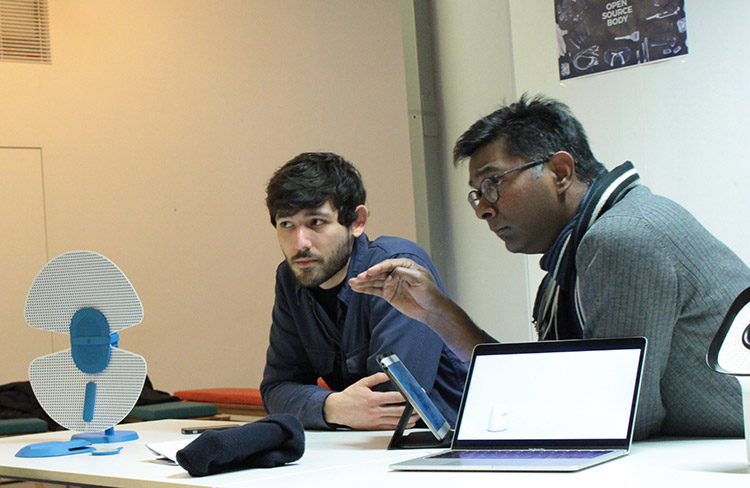
January 27, 8pm, at La Gaîté Lyrique, Deshmukh Gopaul is “tired, but happy”. Tired from the long afternoon meeting the public at Open Source Body, which ranged from philistines to biohackers to artists interested in open source. Happy to have met other actors who believe that the future of science lies in sharing skills. Deshmukh is a researcher at Institut Pasteur, where he directs the Design for Biology department at the Center for Innovation and Technological Research (Citech). This afternoon, he is wearing the hat of mentor for the 2017 iGEM-Institut Pasteur team, which includes 14 students who competed at iGEM (international Genetically Engineered Machine), the prestigious international student competition to promote synthetic biology. He presented the highly praised prototype Æther, a kit to fight indoor air pollution, which won the bronze medal at iGEM in November 2017.
The object itself resembles a simple fan. But Æther captures air polluters in water using a hydrophobic silk web that accumulates droplets… or recycles them. “On this filter that captures fine particules, we place enzymes capable of completely degrading their molecules,” he explains, adding: “Our device is human-sized, meant for individual use, in an apartment, for example. It was designed from very cheap materials.” Now the professor dreams of bringing the product to the market, especially given the interdisciplinary nature of the iGEM-Institut Pasteur team—biologists (UPMC), chemists (ParisTech chemistry), engineers (Centrale-Supélec, Polytechnique, ESPCI), legal experts (Paris-Saclay University) and designers (ENSCI-Les Ateliers) all collaborated on developing Æther.
Enrico Bassi and the platform of materials for open science
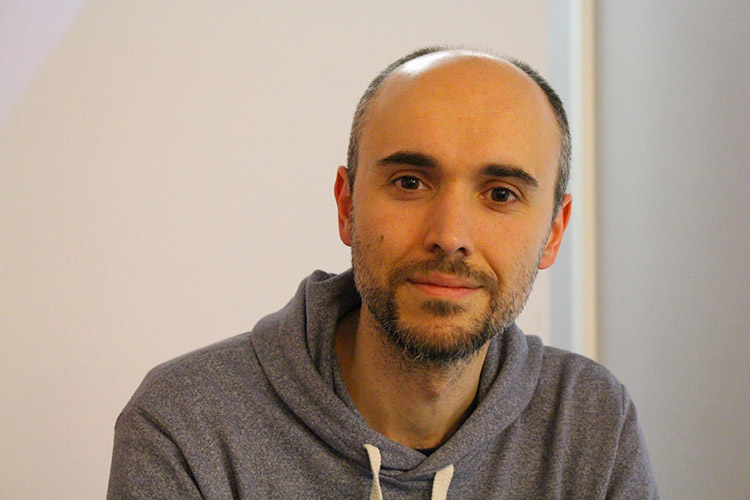
“Makers don’t like to replicate, they like to offer original solutions. They make them to prove that it’s possible, then they move on to another project,” says Enrico Bassi, coordinator of Opendot fablab in Milan, who presented at La Gaité Lyrique in a world exclusive Made4you, a database that aims to compile solutions by makers in the fields of healthcare and medical treatment. It’s a European platform for co-creating open medical equipment, which was launched in a meeting on January 16 at Fab Lab Berlin, in cooperation with Waag Society. To support the project in industry, Enrico also signed a partnership with the British open hardware platform Wevolver. “We wanted the project to be useful above all,” he says, in other words, that people seeking medical solutions could refer to a single source and express their problem in simple terms. This principle became the topic of many work meetings to come with makers as well as health professionals.
Enrico’s other preoccupation is the sustainability of the project, funded for three years by the European Union. “We imagine the use and fabrication of solutions to be remunerated,” says Enrico. A sort of marketplace for open hardware medical solutions? “No solution is out of the question.” As an innovation designer from the Polytechnic school in Milan, Enrico helped hatch the maker movement in Italy. In 2011, he coordinated the very first Italian fablab, Fablabitalia, then presided over Fablab Torino until 2014 before joining Opendot in Milan. This designer who officiated in Miami now teaches digital fabrication at prestigious Italian design academies. In 2015, Enrico successfully completed the Fab Academy, the international course led by the father of fablabs and MIT professor Neil Gershenfeld, and subsequently became one of its instructors.
Dasha Ilina and DIY against technopain
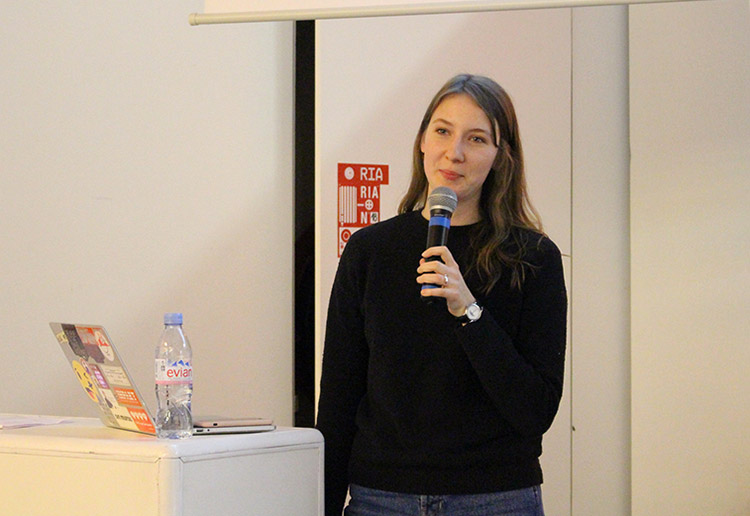
Dasha Ilina was a bit intimidated about speaking in front of all these eminent researchers and biohackers. She signed up online to participate in the mini project presentations of Open Source Body on January 27 at La Gaîté Lyrique Resource Center. She revealed the first prototypes of her Center for Technological Pain, “DIY solutions to eradicate health problems linked to mobile technology”, which attracted interest: “How can we participate?” “Are the tutorials open source?”…
Dasha Ilina is a young Russian artist studying art, media and technology at Parsons Paris. She explains: “Like a lot of people these days, I’m addicted to technology, so I’ve started to develop tools to wean myself off them. I think that humans should be able to abuse technology, rather than the opposite.” She then shows mechanical blindfolds, “ocular fatigue reducers” that incorporate an Arduino, which force you to rest your eyes from the screen. Slightly more invasive and just as silly: a smartphone accessory covered with (cardboard) spikes to learn to hold the phone away from your ear (when it’s hot, it’s harmful to the body); a (cardboard) hands-free headset to revisit augmented reality in low-tech mode. In her Center for Technological Pain, she studies self-defense techniques to protect herself from overexposure to radiowaves (an animated GIF shows her pulling back the ears of a self-involved user to reach the correct posture). Fresh, ironic, caustic.
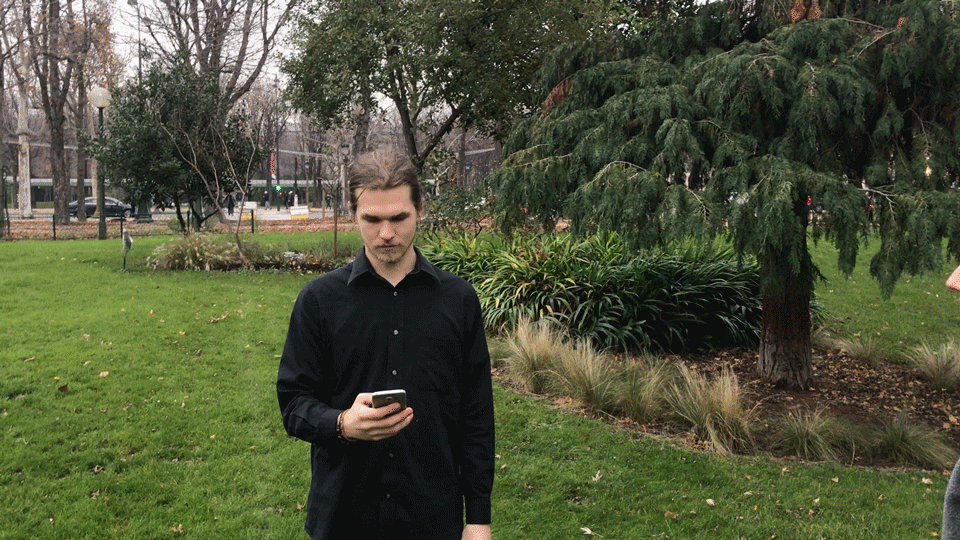
Isabelle Giami and gynecology in high-risk areas
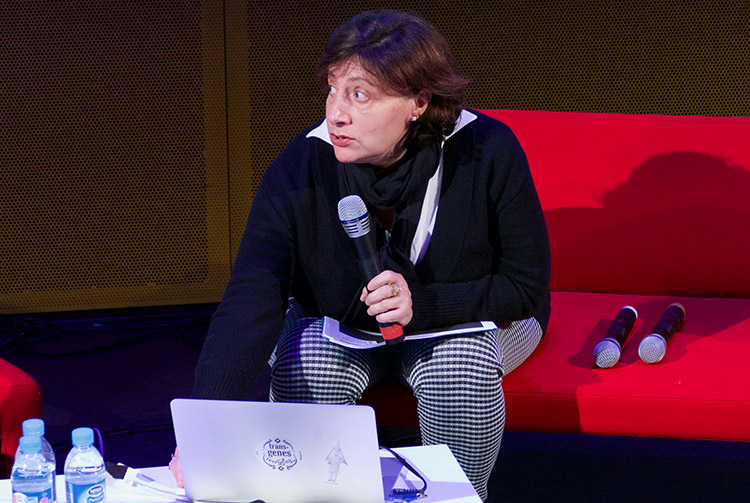
Isabelle Giami, hospital midwife at Centre Hospitalier de Plaisir and administrator of Gynécologie sans frontières (GSF), participated in the discussion “What are the best tools for rapid diagnosis in gynecological healthcare?” at La Gaîté Lyrique on January 27. GSF, an NGO founded in 1995, helps women around the world by palliating the lack of healthcare organizations in situations of humanitarian crisis. There is also an urgency in France, she says, talking about her experience of the Camparis projects, gynecological and obstetric consultations in the migrant camp in Ivry near Paris, as well as Caminor, a mobile gynecological dispensary in the northern French region of Nord-Pas-de-Calais. Confronting maker tools to her experience out in the field, she points out that “We don’t have any immediate need in echo scans, but sometimes there are situations where we’re missing a simple thermometer.” GSF is already working with organizations to reuse medical devices. Practically speaking, besides gynecological care associated with protecting mother and child, there is a need for diagnostic tools to detect breast and cervical cancer. The influence of cultural factors, relationship to nudity and the difficulty in using invasive techniques such as probes make diagnosis that much harder.
With a master degree in ethnology on hospital care in Paris for migrant women from West Africa and a DESS in community health specialized in prenatal care, Isabelle Giami established and managed the city hospital prenatal care network in northern Paris to offer better access to healthcare for women in need, before training midwives at CHI Poissy-Saint-Germain-en-Laye in western Paris. She insists on the invaluable nature of this profession, especially for the wide range of care it provides: “For the past few years, midwives even have the ability to practice medical abortion.”
Read also our full report of the Open Source Body festival
